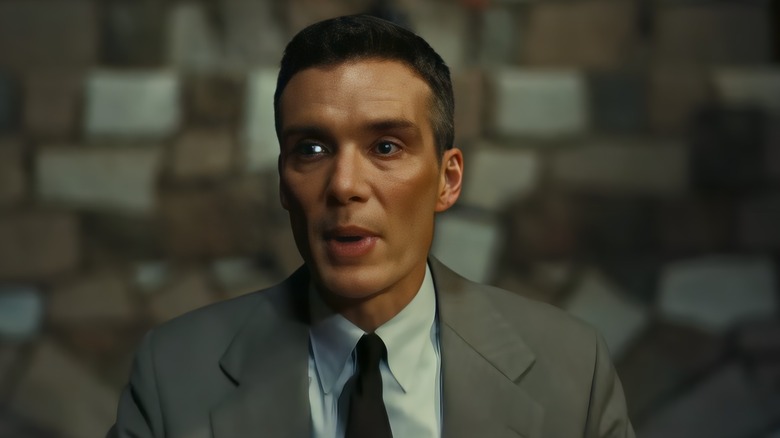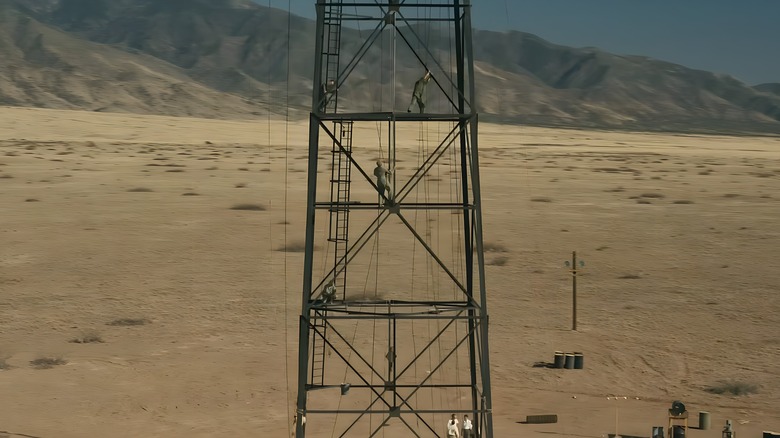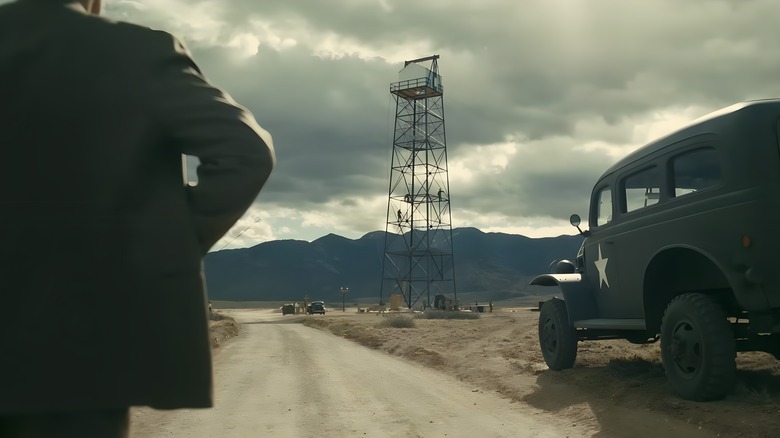Oppenheimer: What Is The Trinity Test? The Real-Life Nuclear Experiment Explained
Contains spoilers for "Oppenheimer"
Before "Oppenheimer" came out in theaters, stories swirled on social media of how director Christopher Nolan and his team pulled off the atomic bomb test, known as the Trinity test, with practical effects. Unlike the bomb detonation in "The Dark Knight Rises," where CGI is fine for a more cartoonish threat, the Trinity Test was meant to inspire fear, which Nolan thought was more challenging to accomplish with CGI. Nolan told IGN, "I first showed the script to Andrew Jackson, my visual effects supervisor, and said, I don't think that tool's going to work for us. So let's see if we can produce all of these effects using analog methods, from the very first imaginings that Oppenheimer has of the quantum world, of atoms, and how they would be interacting with strong force between them. Waves, particles, the duality of that."
Suffice it to say, the Trinity test sequence in "Oppenheimer" is one of the most visually-arresting scenes put to film. The tension throughout is palpable, as there's a non-zero chance the explosion could result in a chain reaction, essentially setting the entire Earth's atmosphere on fire. The world doesn't end, but a massive explosion ensues, with a mushroom cloud filling the sky and a bright light illuminating the surrounding area. Everyone in the vicinity waits until it's okay to look at the detonation through special glass, and it takes some time for the shock wave to hit everyone. It's a fairly accurate depiction of what happened during the Trinity test, a pivotal moment in the history of humanity.
What happened during the Trinity test?
On July 16, 1945, the first nuclear explosion in the world took place and was a success, ushering in the Atomic Age. 210 miles south of Los Alamos, where the Manhattan Project took place in New Mexico, a 100-foot tower helped detonate the bomb, referred to as the "Gadget." It went off at 5:30 a.m. MWT, setting off 18.6 kilotons of power. The tower was instantly vaporized, and the nearby sand and asphalt turned into a green glass, later known as "trinitite." It's noted that it took 40 seconds for the shock wave to hit nearby observers, many of whom fell to the ground, as depicted in "Oppenheimer."
The test was a success, signaling how the United States could use atomic weaponry and forever changing the landscape of warfare. But for the time being, the military needed to keep the project under wraps, and civilians absolutely detected the blast. Witnesses noticed the detonation from as far as 200 miles away, and beforehand, Leslie Groves (Matt Damon's character in "Oppenheimer") prepared a press release to assuage fears. Part of the press release read: "A remotely located ammunition magazine containing a considerable amount of high explosives and pyrotechnics exploded. There was no loss of life or injury to anyone, and the property damage outside of the explosives magazine was negligible."
The actual cause of the detonation was only revealed after the bombing of Hiroshima on August 6, 1945.
Several people wrote about witnessing the Trinity test
The Trinity test marked a shift in human culture. Military personnel and politicians were likely thrilled the test was a success, and the country now had a weapon to supersede all others. However, "Oppenheimer" presents it as a catastrophic moment when mankind could now annihilate itself with the greatest of ease. Several eyewitness accounts emerged in the aftermath of the Trinity test. Ralph Carlisle Smith watched the detonation from Compania Hill, who later stated, "The ball of fire seemed to rise in something of toadstool effect. Later the column proceeded as a cylinder of white smoke; it seemed to move ponderously. A hole was punched through the clouds, but two fog rings appeared well above the white smoke column. There was a spontaneous cheer from the observers."
Oppenheimer himself spoke of the magnitude of witnessing such an event, recalling a verse from the Bhagavad Gita, "If the radiance of a thousand suns were to burst at once into the sky, that would be like the splendor of the mighty one." He later explained another far more famous verse that entered his mind at the time, "Now I am become Death, the destroyer of worlds."
The Trinity test can now be viewed as a harbinger to come, where numerous nations now have nuclear arsenals, ready to fire at any provocation. Oppenheimer's statement at the end of Christopher Nolan's movie about how they actually did set off a chain reaction that will (at some point) destroy the world may come to fruition because man wasn't meant to harness such power. "Oppenheimer" is playing in theaters now.


